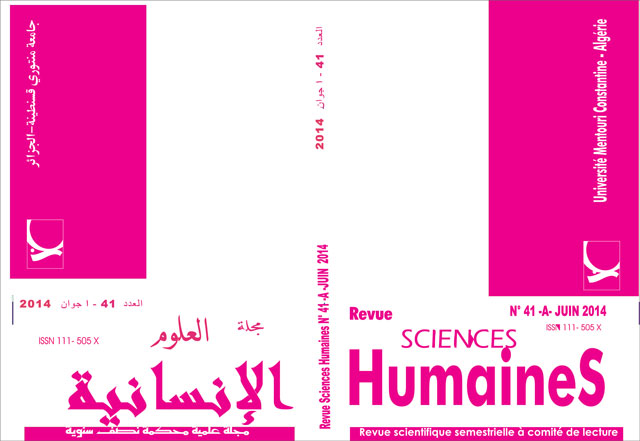Benchmarking de la performance du Tourisme Maghrébin : Approche par la Prise de Décision Multi-Critère
الملخص
Cette étude vise à développer un cadre de benchmarking qui évalue la performance touristique dans les pays maghrébins, qui révèle leurs forces et faiblesses et enfin qui identifie et privilégie les alternatives possibles pour une amélioration continue. Une méthodologie basée sur le AHP - TOPSIS a divisé l'ensemble du benchmarking en deux étapes. La première étape est l’« Analytic Hierarchy Process » (AHP), où l’identification, la synthèse et la hiérarchisation des facteurs de performance clés sont faites, et une échelle de mesure compatible est développée. La deuxième étape est la « Technique for Order preference by Similarity to Ideal Solution » (TOPSIS). Elle permet l’évaluation des solutions alternatives possibles pour l'amélioration continue de la performance des destinations étudiées. Le cadre proposé peut aider les destinations à déterminer les forces et les faiblesses de leurs performances. Ils peuvent également identifier les meilleures pratiques de chaque pays et donc, le benchmark pour améliorer les faiblesses sans perdre de vue les conditions et les stratégies opérationnelles actuelles de la destination. Enfin, ce cadre facilite aux décideurs des stratégies la planification des stratégies futures afin de développer la performance de l'industrie du tourisme et son impact sur l'économie locale.التنزيلات
المراجع
Andersen B, Pettersen P., (1996), “The benchmarking handbook”, Chapman & Hall.
B. Marr, G. Schiuma, (2003), “Business performance measurement: past, present and future”, Management Decision, Vol. 41 pp 680 – 687.
Bramwell, B., and Rawding, L., (1996), “Tourism marketing images of industrial cities”, Annals of Tourism Research, Vol. 23 Iss: 1, pp 201 – 221
Camp R., (1995), “Business process benchmarking: finding and implementing best practices”, Milwaukee ASQC Quality Press, 299 p.
Luštický M., Kincl T. and Musil M, (2011), “Tourism development planning in selected EU countries”, MANAGEMENT RESEARCH AND PRACTICE, Vol. 3 Iss: 1, pp: 48 - 61.
Enright, M.J., and Newton, J., (2004), “Tourism destination competitiveness: a quantitative approach”, Tourism Management, Vol.25 Iss: 6, pp 777 – 888
Fernandez, P., McCarthy, I.P. and Rakotobe-Joel, T., (2001), “An evolutionary approach to benchmarking”, Benchmarking: An International Journal, Vol. 8 Iss: 4, pp 281 - 305
Forman EH, Gass SI, (2001), “The analytic hierarchy process – an exposition”. Operations Research, Vol.49 Iss: 4, pp 469–486
Gumus, A. T. (2009). “Evaluation of hazardous waste transportation firms by using a two step fuzzy-AHP and TOPSIS methodology”. Expert Systems with Applications, Vol. 36, pp 4067–4074.
Gunasekaran, A., Patel, C., & Tirtiroglu, E., (2001), “Performance measures and metrics in a supply chain environment”, International Journal of Operations & Production Management, Vol. 21 Iss: 1, pp 71–87.
Guo, L.F., (2000), “Thoughts on international competitive power of Chinese tourism”, Tourism Science, Vol.2, pp 12 - 15
Hong Zhang, Chao-Lin Gu and Yan Zhang, (2011), “The Evaluation of Tourism Destination Competitiveness by TOPSIS and Information Entropy”, Tourism Management, Vol. 33 pp 443 - 451
Hsieh, L. F., Chin, J. B., & Wu, M. C., (2006), “Performance evaluation for university electronic libraries in Taiwan”, The Electronic Library, Vol. 24 Iss: 2, pp 212–224.
Lin, M. C., Wang, C. C., Chen, M. S., & Chang, C. A., (2008), “Using AHP and TOPSIS approaches in customer-driven product design process”, Computers in Industry, Vol.59, pp 17–31.
Maylor H., (1999), “Project management”, 2nd ed. London: Financial Times.
Mohammad Reza Mehregan, Mahmoud Dehghan Nayeri, Vahid Reza Ghezavati, (2010),"An optimisational model of benchmarking", Benchmarking: An International Journal, Vol. 17 Iss: 6 pp. 876 – 888
Navneet Bhushan and Kanwall Rai, (2003), “Strategic Decision Making: Applying the Analytical Hierarchy Process”, CABI Publications, pp 12 – 15
Owen JM, (2000), “Linking benchmarking techniques to principles of evaluation practice”, Eval News Comment, Vol. 9 Iss: 1 pp 19–21
Paul Phillips and Panos Louvieris, (2005), “Performance Measurement Systems in Tourism, Hospitality, and Leisure Small Medium-Sized Enterprises”, Journal of Travel Research, Vol. 44 Iss: 2, pp 201 - 212
Saaty, T.L. (1980), The Analytic Hierarchy Process, McGraw-Hill, New York, NY.
Saaty TL (1990) An exposition of the AHP in reply to the paper “Remarks on the analytic hierarchy process”.Management Science 36(3).
Saunders, M., Mann, R., & Smith, R. (2007). Benchmarking strategy deployment practices. Benchmarking: An International Journal, 14(5), 609–623.
Yasin, M., (2002), “The theory and practice of benchmarking: then and now”, Benchmarking: An International Journal, Vol. 9 Iss: 3, pp 217 - 43
Zahedi, F. (1989), “The Analytic Hierarchy Process – a survey of the method and its applications”, Interfaces, Vol. 16 No. 4, pp. 96-108.












